Satellite crash – live: Out-of-control ERS-2 falls to Earth
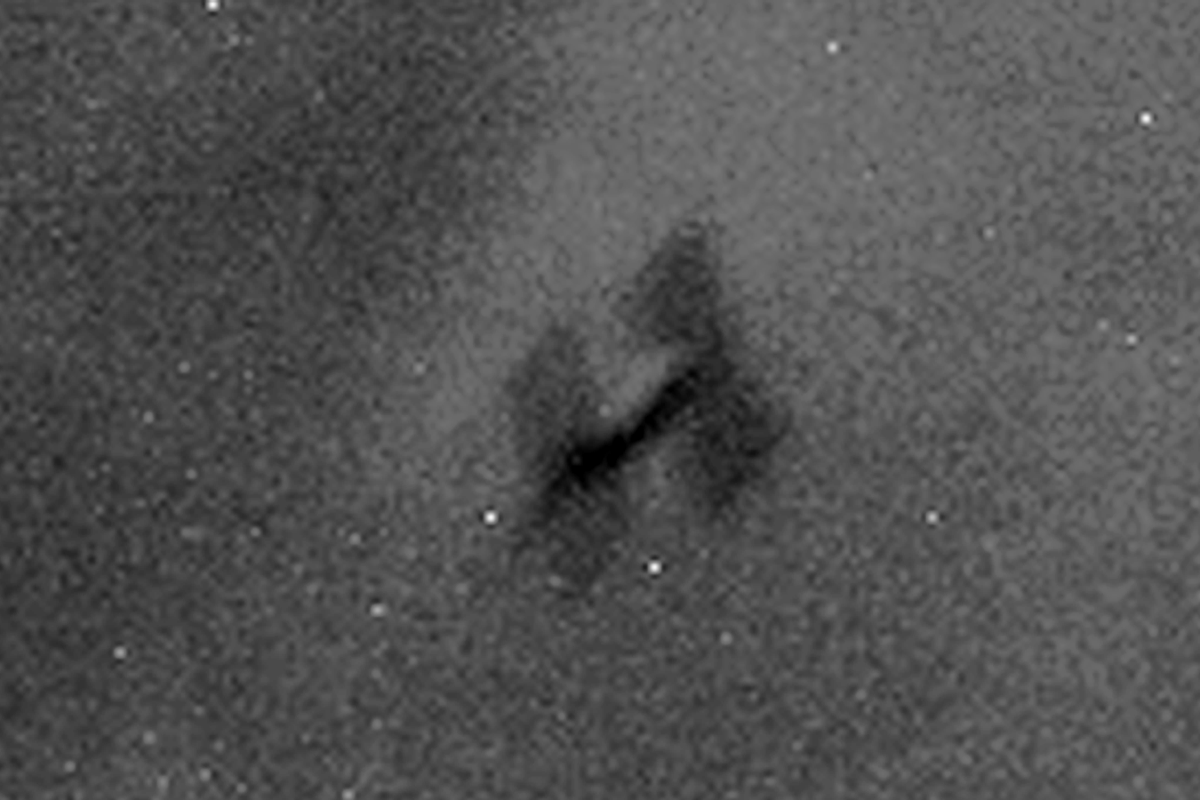
An out-of-control satellite has fallen to Earth, nearly three decades after it launched.
The ERS-2 satellite, which served as an observation platform after launching in 1995, landed in the Pacific Ocean between Alaska and Hawaii on Wednesday.
The European Space Agency (ESA) said the risks associated with the two-tonne satellite were “very low”, however there was still a chance that fragments could hit populated areas.
Mirko Albani from ESA’s Earth Observation Ground Segment Department said: “It’s worth highlighting that none of the elements that might re-enter the atmosphere (and reach the surface) are radioactive or toxic.”
The predicted time for the satellite entering the Earth’s atmosphere was originally 3.49pm GMT (10.49 EST) on Wednesday, however it remained orbiting the planet for up to an hour.
You can follow all the latest news, updates and developments of the ERS-2 satellite as it heads towards Earth in our live blog below.
Key points
How dangerous is the ERS-2 satellite falling to Earth
Where did the ERS-2 satellite fall to Earth
More on ERS-2’s mission
Satellite crash live: ESA confirms ERS-2 reentry
Wednesday 21 February 2024 20:19 , Anthony Cuthbertson
The European Space Agency has finally confirmed that the two-tonne satellite reentered the Earth’s atmosphere somewhere between Alaska and Hawaii.
UPDATE 19:30 UTC (20:30) CET
We have confirmation of the atmospheric reentry of ERS-2 at 17:17 UTC (18:17 CET) +/- 1 minute over the North Pacific Ocean between Alaska and Hawaii.
Coordinates: https://t.co/BNX4K1YxW2— ESA Operations (@esaoperations) February 21, 2024
Hello and welcome...
Wednesday 21 February 2024 09:06 , Anthony Cuthbertson
to The Independent’s live coverage of the ERS-2 satellite. Nearly 30 years after it launched, and 13 years after it was decomissioned, the satellite is finally set to return to Earth.
At any point between midday and 9pm GMT on Wednesday (7am to 6pm EST), the space junk could re-enter the Earth’s atmosphere.
While most of it will likely burn up, the European Space Agency (ESA) has warned that there is still a chance of fragments crashing into populated areas.
You can follow all the latest updates right here.
Satellite crash live: What was ERS-2’s mission?
Wednesday 21 February 2024 09:21 , Anthony Cuthbertson
The ERS-2 satellite has been out of service since 2011, having launched from Europe’s Spaceport in French Guiana on 21 April, 1995.
Alongside its sister satellite ERS-1, it has been described as the “grandfathers of Earth observation” in Europe, offering never-before-seen insights into the Earth’s climate and environment.
Both satellites carried a Synthetic Aperture Radar (SAR) and a radar altimeter for studying sea surface temperatures and winds, while the ERS-2 also carried a sensor for atmospheric ozone research.
This gave scientists the ability to monitor the Earth’s protective ozone layer in new ways, while also contributing to our understanding of how climate change is having a significant impact on ocean-surface temperatures.
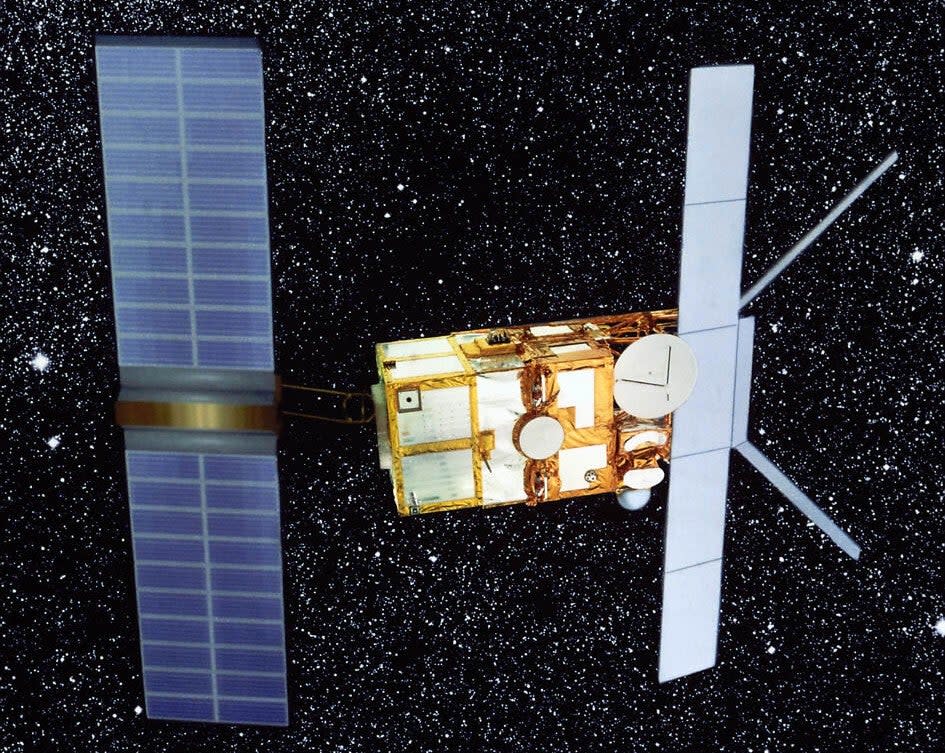
Satellite crash live: When will ERS-2 fall to Earth?
Wednesday 21 February 2024 09:44 , Anthony Cuthbertson
The latest update from the ESA states that the ERS-2 will re-enter the Earth’s atmosphere at approximately 4.32pm GMT (11.32pm EST) on Wednesday.
This prediction, made using data acquired on 20 February, has an uncertainty of +/- 4.61 hours, meaning it could fall any time between midday and 9pm.
“This uncertainty is due primarily to the influence of unpredictable solar activity, which affects the density of Earth’s atmosphere and therefore the drag experienced by the satellite,” the space agency states.
As the reentry time approaches, the uncertainty window decreases, so we should get an increasingly clear idea of when to expect ERS-2’s arrival as the day progresses.
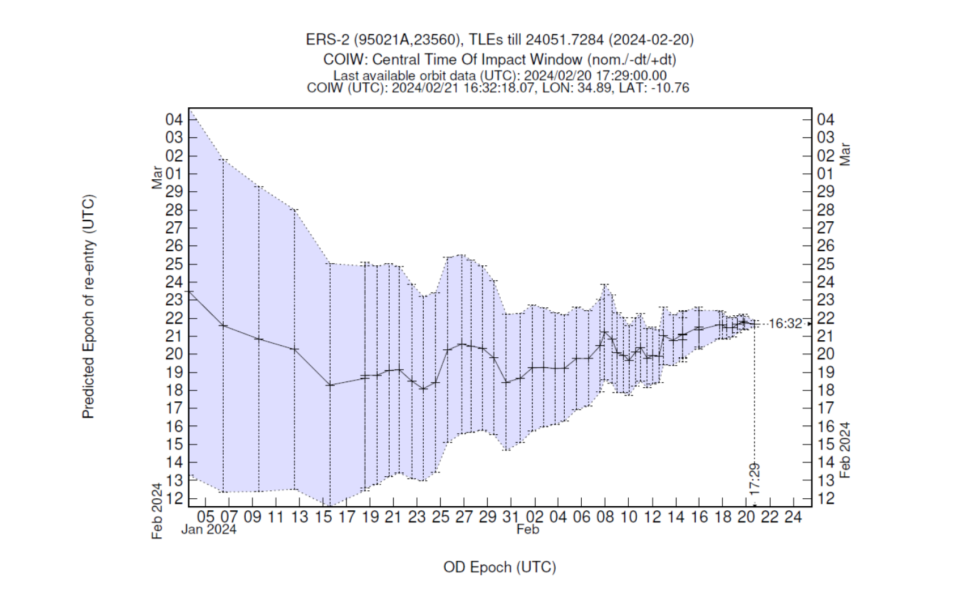
Satellite crash live: Where will ERS-2 fall to Earth?
Wednesday 21 February 2024 10:23 , Anthony Cuthbertson
Just like predicting the time that the ERS-2 satellite will reenter the Earth’s atmosphere, predicting the place also requires a bit of guess work.
The current predicted time of 4.32pm GMT would put the satellite’s reentry over east Africa, as shown by the red marker on this map.
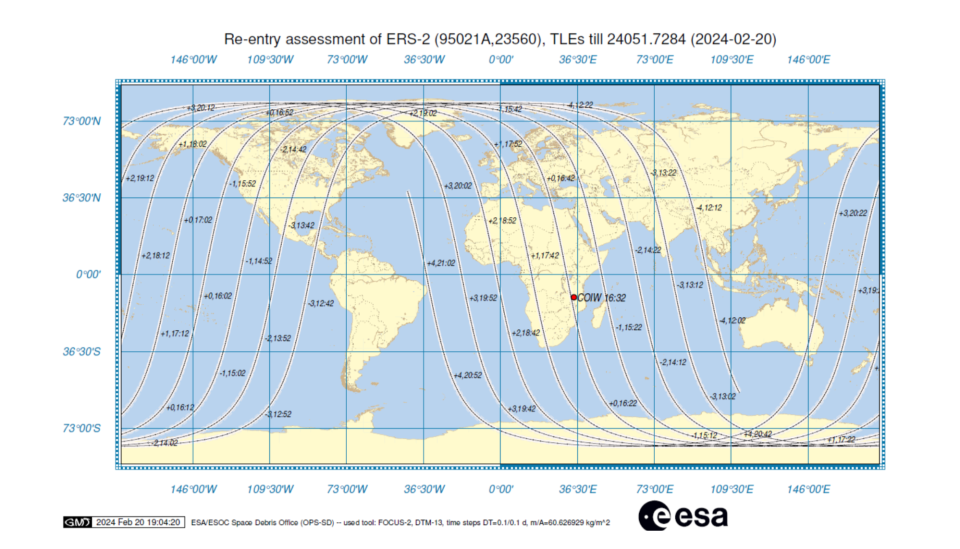
However, given the nine hour window in which it could fall, the satellite could fall along any of those lines, which also cross Europe, North America, Asia and parts of Oceania.
“The ground track passes over a wide range of latitudes due to the nature of ERS-2’s important mission,” the ESA notes on its satellite tracking site.
“ERS-2 was designed to shed light on Earth’s changing climate at a time when humankind’s impact on the environment was not understood as well as it is today. To achieve this, ERS-2 was placed into a ‘Sun-synchronous’ orbit – a type of polar orbit that allowed it to pass over and study a large portion of Earth’s surface.”
Satellite crash live: What will happen to ERS-2 when it reenters Earth’s atmosphere?
Wednesday 21 February 2024 10:52 , Anthony Cuthbertson
The two-tonne ERS-2 satellite is one of the larger pieces of space junk to reenter the Earth’s atmosphere in recent years, meaning it is unlikely that all of it will burn up upon reentry.
The European Space Agency warns that it will break up into fragments around 80 kilometres above the Earth’s surface, with whatever remains then falling across a huge area.
The space agency states: “The vast majority of the satellite will burn up, and any pieces that survive will be spread out somewhat randomly over a ground track on average hundreds of kilometres long and a few tens of kilometres wide.”
None of the fragments that do make it to Earth will contain any toxic or radioactive substances, though there is still potential risk that the projectiles could cause damage or even injury. According to the ESA, this risk is “very, very low”.
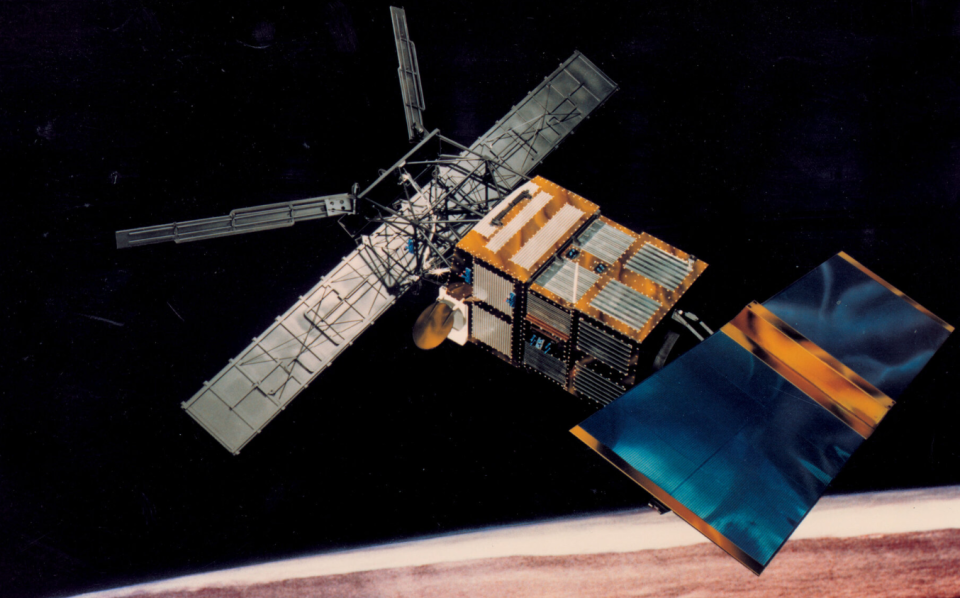
Satellite crash live: What’s the chance of being hit by space junk?
Wednesday 21 February 2024 11:49 , Anthony Cuthbertson
It’s hard to calculate exactly how much space junk falls into Earth’s atmosphere each year, though estimates from the US National Oceanic and Atmospheric Administration (NOAA) suggest it is between 200-400 tracked objecs each year.
Some objects are able to enter in a controlled way by using any onboard fuel reserves to aim into the ocean, though satellites like ERS-2 have no such option.
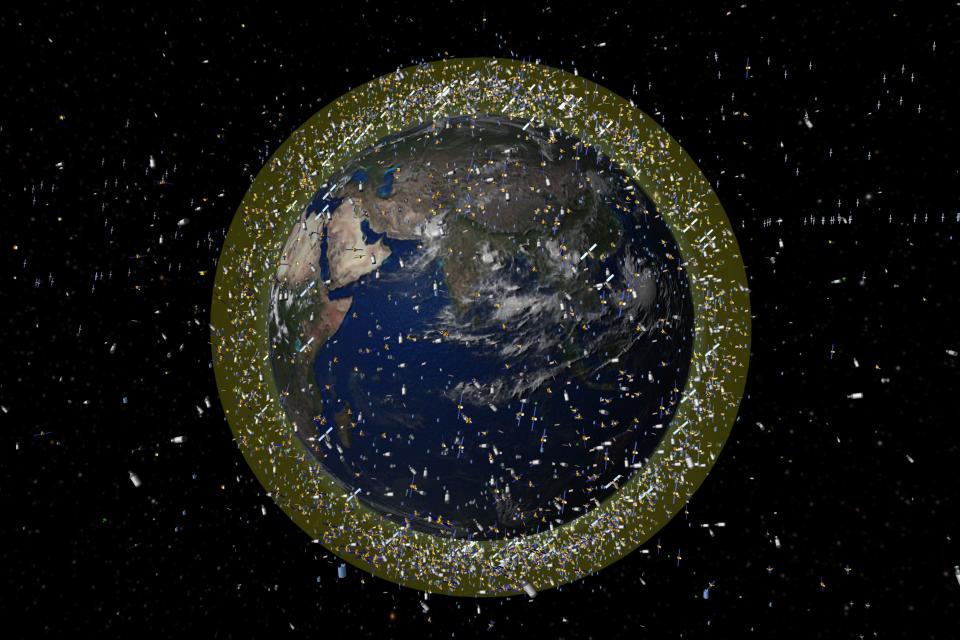
Despite their out-of-control nature, the risk of actually being hit by a piece of space debris falling to Earth is around 1 in 100 billion.
This is:
~1.5 million times lower than the risk of being killed in an accident at home
~65,000 times lower than the risk of being struck by lightning
~three times lower than the risk of being struck by a meteorite
Satellite crash live: ESA updates time of reentry prediction
Wednesday 21 February 2024 12:05 , Anthony Cuthbertson
The European Space Agency (ESA) has recalculated the predicted reentry time for the ERS-2 satellite.
ESA scientists now estimate that the satellite will enter the Earth’s atmosphere at 15.49 GMT (10.49 EST), roughly 45 minutes earlier than previously anticipated. The uncertainty window has also narrowed to just +/- 1.76 hours, meaning it could fall any time between 2pm and 5.30pm on Wednesday.
The closer we get to the actual moment of reentry, the more accurate the prediction will be.
Here’s the latest prediction:
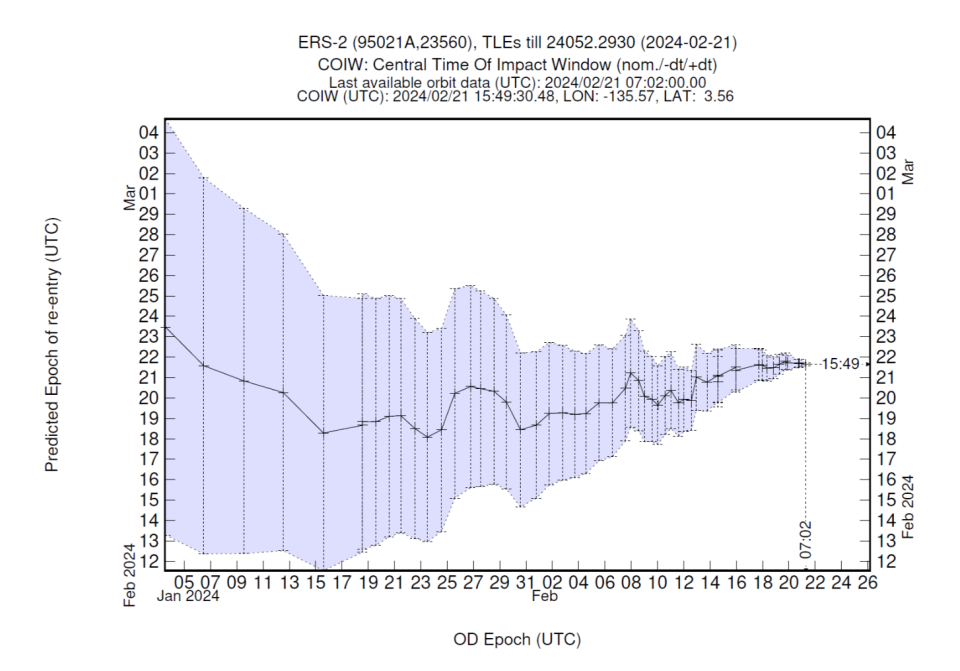
Satellite crash live: ESA revises ERS-2 reentry point
Wednesday 21 February 2024 12:27 , Anthony Cuthbertson
The ERS-2 satellite is no longer expected to fall over east Africa, with the ESA’s updated forecast putting its reentry point over the Pacific Ocean. This is where most decommissioned satellites end up when their operators are able to control it, so this would be an ideal spot. Unfortunately, there’s still a big window of error that could see it crash over the US or Europe.
“At the current predicted time of reentry, 15.49 GMT, 21 February, ERS-2 will be located approximately 80 km over the red marker, labelled COIW (centre of impact window),” the update states
“It is here that we currently expect the satellite to begin to break up. The vast majority of the satellite will burn up, and any pieces that survive will be spread out somewhat randomly over a ground track on average hundreds of kilometres long and a few tens of kilometres wide.”
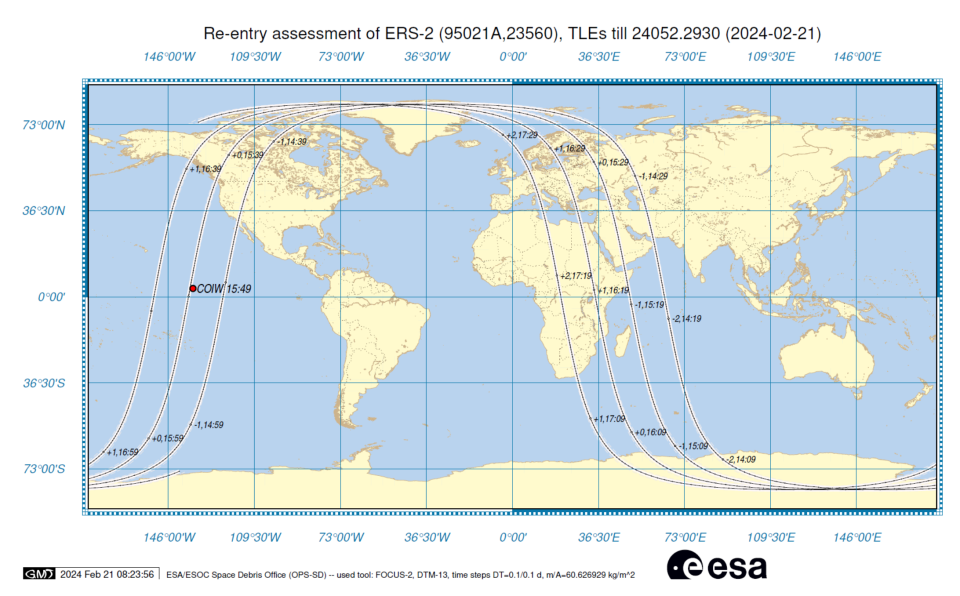
Satellite crash live: ESA estimates reentry close to US
Wednesday 21 February 2024 12:38 , Anthony Cuthbertson
Another update from the European Space Agency has revised the satellite’s expected reentry point to just off the west coast of the US.
This may be the final update before the ERS-2 reentry, the space agency said.
🚨 Possible final update prior to the reentry of ERS-2 🚨
ESA's Space Debris Office predicts that the #ERS2reentry will take place at:
15:41 UTC (16:41 CET) today, 21 February 2024
The uncertainty in this prediction is +/- 1.44 hours.
-- A note on the ground track --
We… pic.twitter.com/2RqrDsVeSW— ESA Operations (@esaoperations) February 21, 2024
Satellite crash live: How to prevent this happening again
Wednesday 21 February 2024 13:33 , Anthony Cuthbertson
We’re approaching the window in which the ERS-2 satellite could reenter the Earth’s atmosphere, according to ESA’s latest calculations.
It’s an approximately 3.5 hour window, starting from around 2pm GMT, that we might see the defunct satellite drop from orbit.
The uncertainty of today’s satellite reentry, together with the associated risks, may soon be a thing of the past. Researchers from various institutions and startups are currently working on technology to better eliminate space junk.
Last month, a Japanese startup unveiled a plan to shoot down space junk using lasers developed for nuclear fusion power. Osaka-based EX-Fusion is taking a novel ground-based approach to dealing with the issue of debris in Earth’s orbit after developing one of the world’s most powerful lasers for the next-generation power source.
You can read more about the effort here:

Nuclear fusion laser could shoot down space junk
Satellite crash live: Watch ERS-2 pass overhead
Wednesday 21 February 2024 14:09 , Anthony Cuthbertson
The window for ERS-2’s possible reentry is now open, meaning it could enter the Earth’s atmosphere anytime between now and 5.30pm GMT.
While we wait, you can watch a video shared by the European Space Agency’s Earth Observation centre in Italy. It shows the doomed satellite passing overhead in real-time.
Just in from our colleagues at @esa's Earth Observation centre outside Rome: footage of the ERS-2 satellite passing over the area yesterday😍🛰️
In the video you can see the fly-by in real speed and slowed down to a quarter of that speed (the satellite was in and out of the frame… pic.twitter.com/1fLqb4r2CC— ESA Earth Observation (@ESA_EO) February 21, 2024
Satellite crash live: What to expect
Wednesday 21 February 2024 15:20 , Anthony Cuthbertson
We’re still waiting to hear from the European Space Agency on the fate of the ERS-2 satellite.
Whenever it deorbits, it may take days, or even weeks, to recover any fragments, presuming some fall on land. If they go into the ocean, there’s a chance they may be lost forever. Obviously, if it falls over anywhere populated, we’ll be hearing about it almost immediately.
Here’s a reminder of what the ESA expects to happen: “The vast majority of the satellite will burn up, and any pieces that survive will be spread out somewhat randomly over a ground track on average hundreds of kilometres long and a few tens of kilometres wide.”
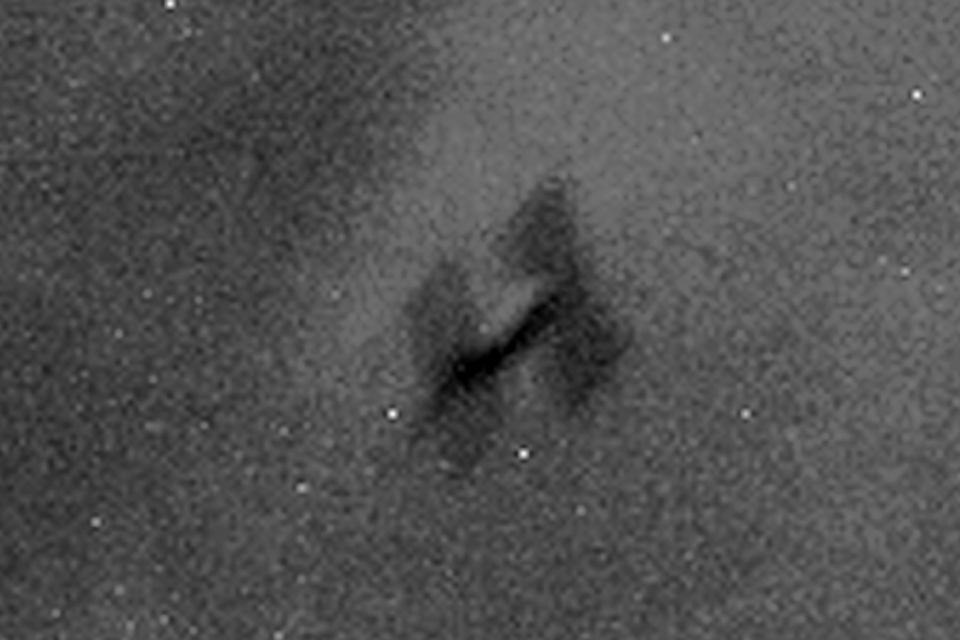
Satellite crash live: ERS-2 deorbit underway
Wednesday 21 February 2024 15:43 , Anthony Cuthbertson
According to the European Space Agency’s estimates, the ERS-2 satellite should be re entering the Earth’s atmosphere at 3.41pm GMT, which is right now.
We’re still waiting for official confirmation from the ESA.
Satellite crash live: Tracker shows ERS-2 clearing US
Wednesday 21 February 2024 15:51 , Anthony Cuthbertson
The ERS-2 satellite has cleared Canada and the United States and is now over the Pacific Ocean, according to satellite tracking site Satflare.
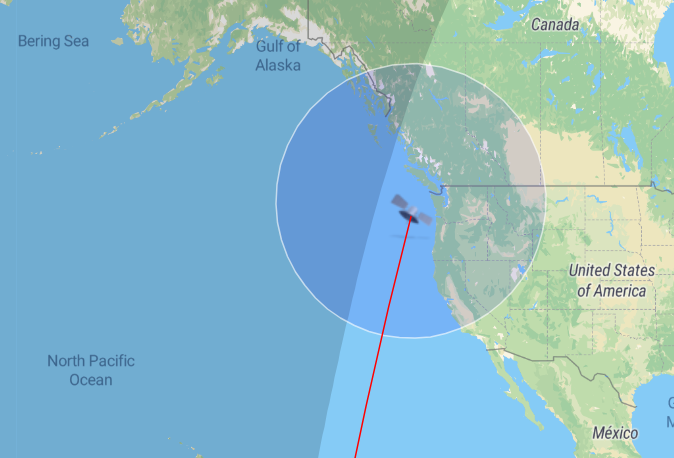
This means it should pose no risk to human life if any fragments survive reentry. If it makes it over the Pacific, the next land will be the Antarctic, before crossing over the Southern Ocean and Indian Ocean and over east Africa.
Satellite crash live: ESA gives latest update
Wednesday 21 February 2024 15:55 , Anthony Cuthbertson
The ESA has just posted to X (formerly Twitter) to tell us that the ERS-2 satellite still seems to be orbiting Earth.
“Nothing to report as of yet,” the space agency writes.
We have now passed the centre of the reentry window. Nothing to report as of yet.
— ESA Operations (@esaoperations) February 21, 2024
Satellite crash live: ERS-2 heading for Point Nemo
Wednesday 21 February 2024 16:07 , Anthony Cuthbertson
The ERS-2 satellite appears to have made it over the North Pacific Ocean and is now passing close to Point Nemo - the point on Earth that is furthest away from land.
This area is also known as Spacecraft Cemetary, as defunct satellites, spacecraft and even space stations have been ditched there in the past.
If ERS-2 were to come down now, ESA would not have been able to plan it better if they had control of it.
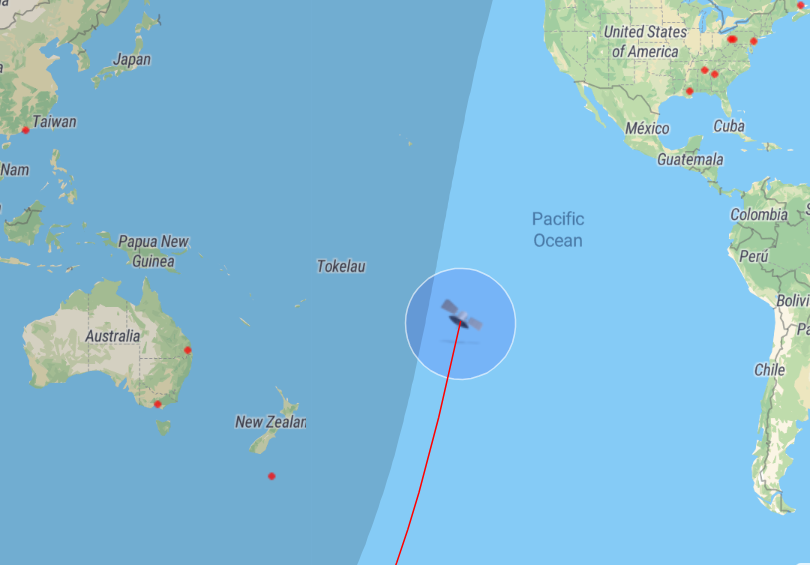
Satellite crash live: ERS-2 heads over South Pole
Wednesday 21 February 2024 16:21 , Anthony Cuthbertson
The ERS-2 is currently making its way over the South Pole. According to the European Space Agency’s previous forecast, it has no more than one hour left to go. It will more likely be a matter of minutes.
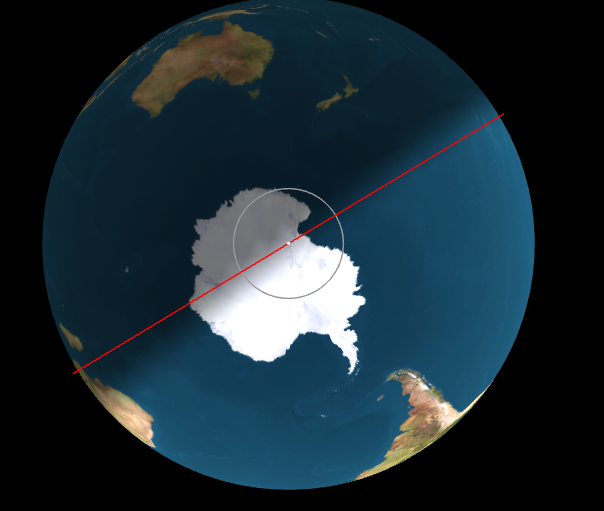
Satellite crash live: ERS-2 tracker shows space junk clearing land
Wednesday 21 February 2024 16:31 , Anthony Cuthbertson
The ERS-2 satellite has once again cleared land, albeit the most sparsely populated continent on the planet.
Satflare shows it now heading north up the Southern Ocean , with its trajectory putting it on course for the east coast of Africa.
Mozambique will be the first country it crosses, followed by Zambia, Malawi, Tanzania, Burundi and Rwanda.
The European Space Agency has warned that any fragments could fall across a radius of tens of kilometres from that line.
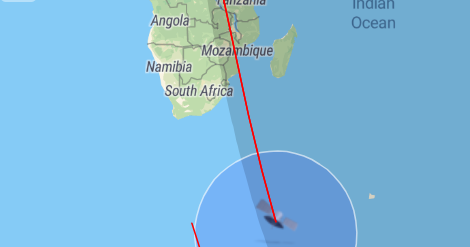
Satellite crash live: ERS-2 tracker shows it heading over Africa
Wednesday 21 February 2024 16:41 , Anthony Cuthbertson
It looks likely that the ERS-2 will be reentering the Earth’s atmosphere over land.
As it heads over Africa it will travel north until a brief crossing of the Mediterranean and over Europe.
This red line shows the path it will take:
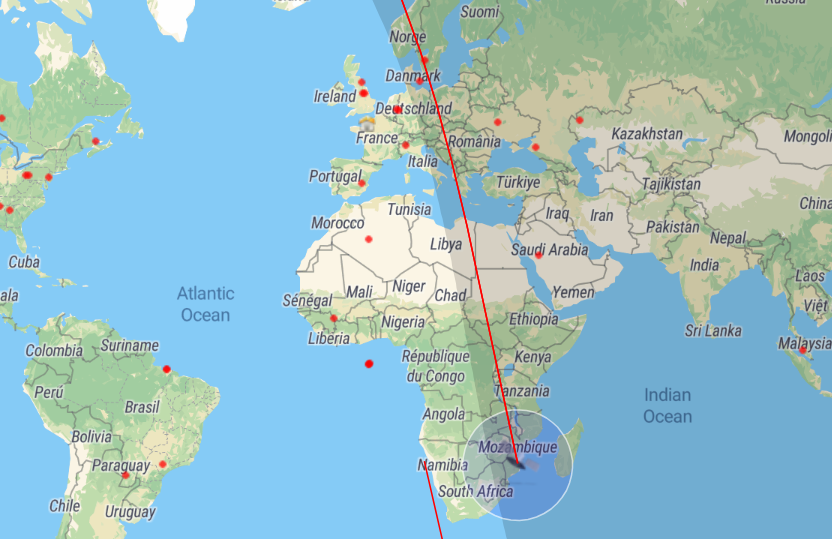
Satellite crash live: ESA gives new prediction for reentry site
Wednesday 21 February 2024 16:47 , Anthony Cuthbertson
We’ve just had an update from the European Space Agency. The latest prediction puts the ERS-2 satellite coming down north of Norway, however there is still a broad window of uncertainty that could see it coming down anywhere from Africa to North America.
🚨 New data! 🚨#ERS2reentry at 17:05 UTC (18:05 CET)
Uncertainty is still approx. 30 minutes. pic.twitter.com/Scfbjcqd4v— ESA Operations (@esaoperations) February 21, 2024
Satellite crash live: ERS-2 heads over Europe
Wednesday 21 February 2024 16:54 , Anthony Cuthbertson
The latest tracking data from Satflare shows the ERS-2 satellite crossing the Mediterranean and over Greece.
It will now head over the Balkans before heading over Central Europe and then into Scandinavia.
This could be a dangerous moment should it come down now, although the odds of anyone being injured by falling fragments remains incredibly low, even over land.
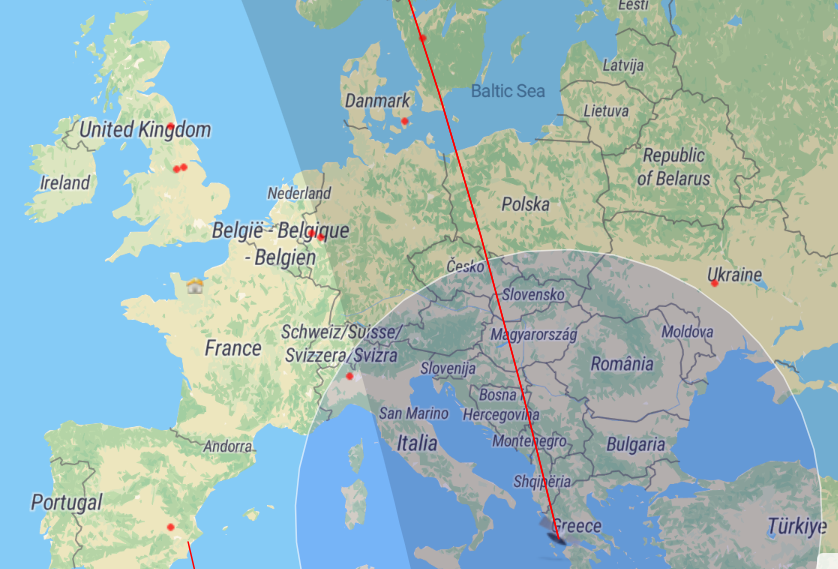
Satellite crash live: ESA revises predicted reentry time
Wednesday 21 February 2024 17:01 , Anthony Cuthbertson
The European Space Agency’s revised time for the ERS-2 satellite’s reentry is 5.04pm GMT, which is in approximately five minutes. There is still a 30 minute window of uncertainty though.
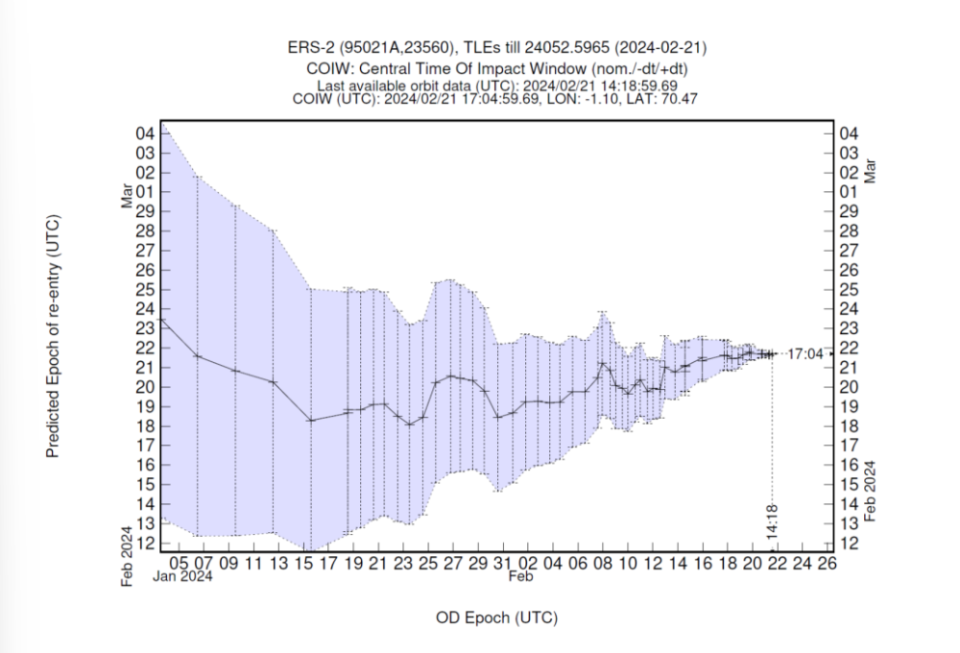
Satellite crash live: ERS-2 heading for North America
Wednesday 21 February 2024 17:06 , Anthony Cuthbertson
The latest tracking data from Satflare shows the ERS-2 satellite passing over Greenland and heading towards northern Canada.
If it continues it will briefly pass over Alaska before heading out over the Pacific Ocean. After that it won’t hit land again until the Antarctic.
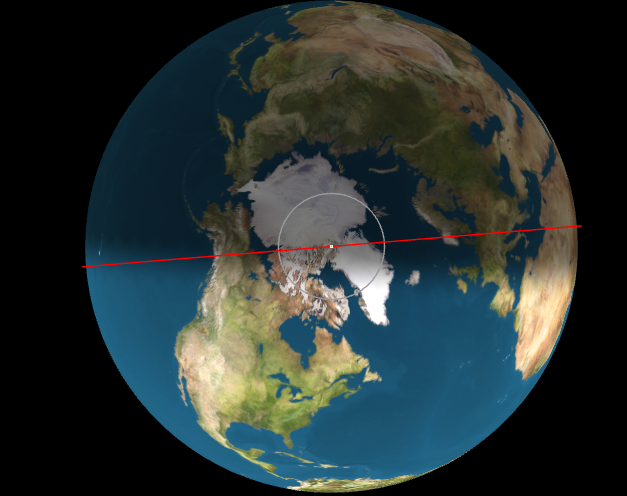
Satellite crash live: Trajectory of ERS-2 looks relatively safe
Wednesday 21 February 2024 17:14 , Anthony Cuthbertson
It looks increasingly likely that the ERS-2 satellite will avoid reentering the Earth’s atmosphere over any populated areas.
There’s just this slice of North America before a vast swath of the Pacific Ocean to cross.
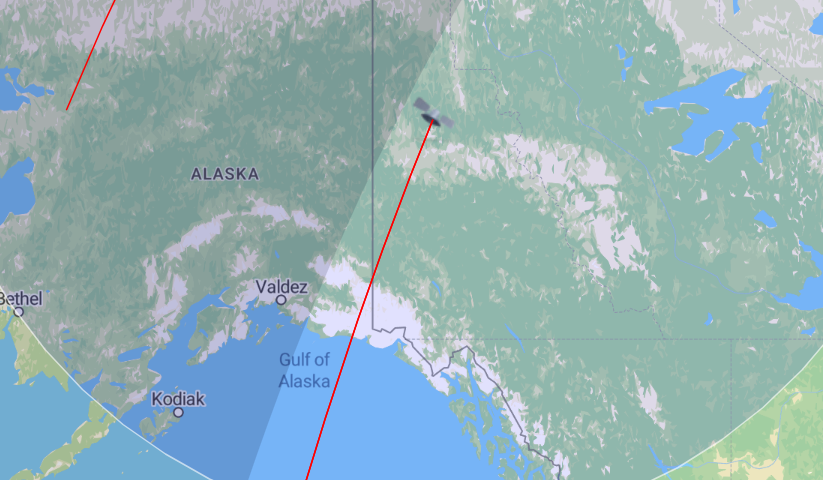
Having written that, I’ve just spotted that it’s on course for heading right over Hawaii.
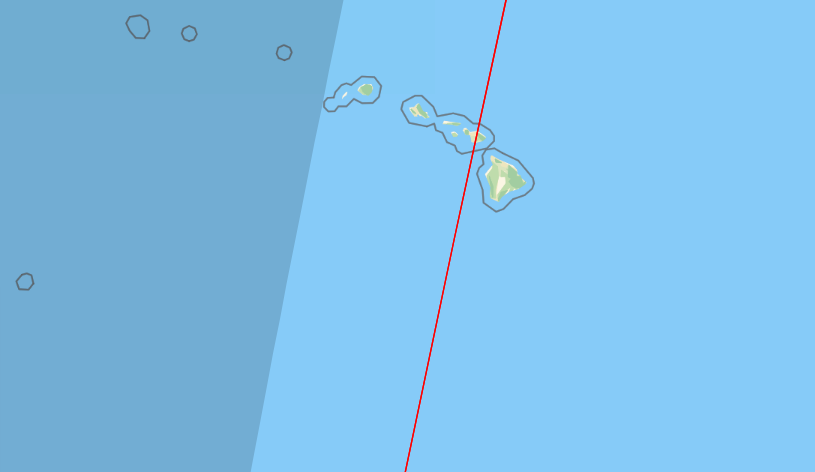
Satellite crash live: ERS-2 clears Hawaii
Wednesday 21 February 2024 17:23 , Anthony Cuthbertson
The ERS-2 satellite has cleared Hawaii, according to the Satflare tracker. There’s a vast expanse of Pacific Ocean before it hits land again, though its reentry is now way overdue.
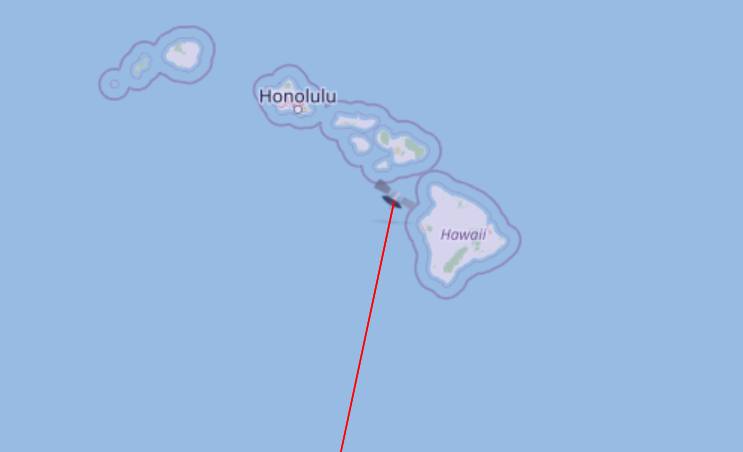
Satellite crash live: ERS-2 passes New Zealand
Wednesday 21 February 2024 17:41 , Anthony Cuthbertson
The ERS-2 is currently passing New Zealand. Next stop Antarctica, before another stretch of ocean and back to Africa.
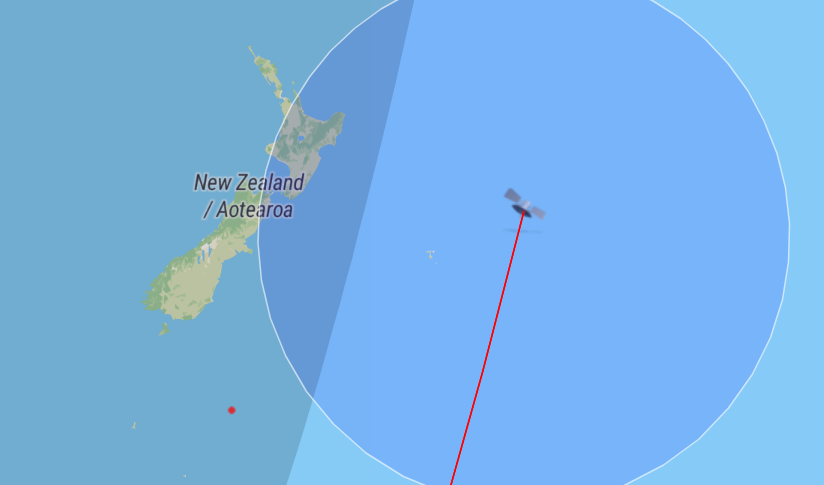
Satellite crash live: ERS-2 clears Antarctica, heads towards Africa
Wednesday 21 February 2024 17:54 , Anthony Cuthbertson
The ERS-2 is now nearly an hour past the predicted reentry time, which the European Space Agency set at 5.04pm.
The third-party satellite tracker Satflare shows that it has cleared Antarctica and is now heading over the Southern Ocean.
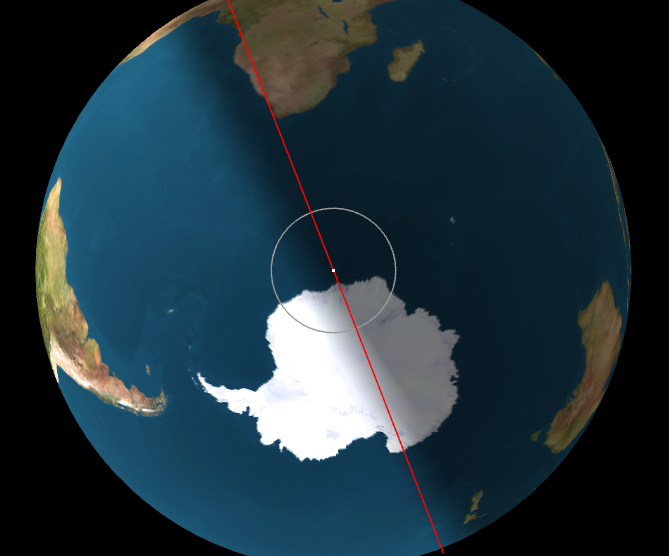
Satellite crash live: ERS-2 ‘may have reentered'
Wednesday 21 February 2024 17:56 , Anthony Cuthbertson
The European Space Agency says the ERS-2 satellite may have already reentered the Earth’s atmosphere, but has no confirmation.
“We have now reached the end of the final reentry window. We have received no new observations of ERS-2,” the space agency posted on X (formerly Twitter).
“This may mean that the satellite has already reentered, but we are waiting for information from our partners before we can confirm. Stay tuned.”
UPDATE 17:35 UTC (18:35 CET)
We have now reached the end of the final reentry window. We have received no new observations of ERS-2. This may mean that the satellite has already reentered, but we are waiting for information from our partners before we can confirm. Stay tuned.— ESA Operations (@esaoperations) February 21, 2024
Satellite crash live: Still no news on fate of ERS-2
Wednesday 21 February 2024 18:13 , Anthony Cuthbertson
We’re still waiting to hear from the European Space Agency to know whether the ERS-2 satellite has officially deorbited.
If it is somehow still in orbit, it will be heading over the north of Africa before skirting by the west of Europe. These projections are not official, and the ESA has already said it has likely reentered the Earth’s atmosphere already - we just don’t know where.
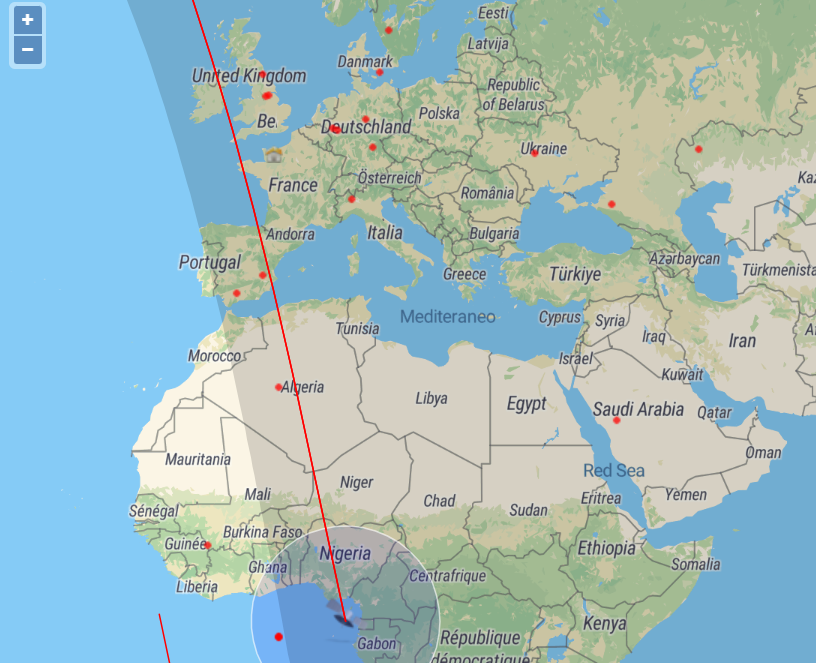
What fallen satellite helped study over its lifetime
06:24 , Vishwam Sankaran
When the ERS-2 satellite was launched, it was the “most sophisticated Earth-observation spacecraft ever developed and launched by Europe,” according to the ESA.
The ERS satellites helped collect a treasure trove of data on Earth’s landmasses, including on the polar ice caps, oceans, and also helped monitor natural disasters and their aftermaths.
UPDATE 19:30 UTC (20:30) CET
We have confirmation of the atmospheric reentry of ERS-2 at 17:17 UTC (18:17 CET) +/- 1 minute over the North Pacific Ocean between Alaska and Hawaii.
Coordinates: https://t.co/BNX4K1YxW2— ESA Operations (@esaoperations) February 21, 2024
“They have provided us with new insights on our planet, the chemistry of our atmosphere, the behavior of our oceans, and the effects of mankind’s activity on our environment – creating new opportunities for scientific research and applications,” ESA said.
The ERS-2 satellite weighing as much as an adult rhino, crashed through the Earth’s atmosphere at 5:17 pm GMT.

